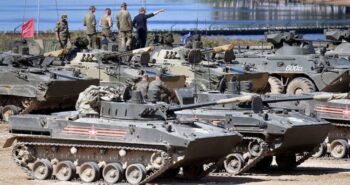Peter Beaumont
 Overshadowed by Syria, the lessons of Libya from the past decade have barely been cross examined. The last days of Libya’s Colonel Muammar Gaddafi 10 years ago conjure up competing images of defiance, defeat and death.
Overshadowed by Syria, the lessons of Libya from the past decade have barely been cross examined. The last days of Libya’s Colonel Muammar Gaddafi 10 years ago conjure up competing images of defiance, defeat and death.
In March 2011, in one of his last public appearances and with rebellion against his regime gathering around him, the soon-to-be-deposed leader arrived at the People’s Congress in Tripoli riding an electric golf cart.
Entering the hall, puffy faced and ageing, Gaddafi punched the air before delivering a lengthy and erratic speech to the gathered “representatives of the people.” Libyans, he thundered, would “fight to the last man and woman” against foreigners if Nato intervened.
He offered money and a new constitution if those rebelling against his rule gave up their fight and blamed al-Qaida and other actors. He warned Libyans they would be “slaves again” if he was gone.
In the streets of his police state beyond the People’s Congress and its obedient representatives, Gaddafi’s notion of freedom was more clear: people who spoke out were disappeared and killed; towns and cities placed under siege.
By August Gaddafi his inner circle was “gone”, fleeing Tripoli after Nato planes led by Britain and France entered the war, their command of skies bending the outcome decisively in the rebels favour.
In October, with the net of rebel forces tightening around the last few blocks his forces still controlled in the city of Sirte, Gaddafi – who had disappeared from view – would try to make a break out of the encirclement, finally caught and killed as he hid in a culvert.
In retrospect, it was that final battle in Sirte that prefigured so much of what would come later including the internecine rivalries between east and west, and rival cities.
Characterised by bitter street to street fighting as the rival rebel brigades from Benghazi and Misrata converged on the regime’s last seafront redoubt, wading sometimes through waist deep water in the flooded streets, the rebels even then seemed often at sharp odds.
Overshadowed by the bloodletting in Syria, the lessons of Libya from the past decade, of Gaddafi’s fall and the conflicts that followed, have barely been cross examined and if they have, then they have been forgotten. It would be a conflict too that would cast a long shadow for international relations, and for the reputations of some.
In 2016 Barack Obama would speak of his disappointment with the European efforts following Gadaffi’s fall suggesting, in particular, that David Cameron had been “distracted” and that had contributed to “the mess” that followed. For former French president Nicholas Sarkozy, the fall out would be more personal and serious: seeing him embroiled in accusations that he had taken campaign money from Gaddafi for his 2007 election.
Originally held up as a model humanitarian intervention under the doctrine of Responsibility to Protect – known by its shorthand of R2P – barely two years after Gaddafi’s fall, Alan Kuperman in the journal International Security was casting Libya not as a success story but a case study in precisely how not to intervene.
By 2016 the chair of the House of Commons foreign affairs select committee, the Conservative MP Crispin Blunt, was equally scathing of the intervention backed by the then Tory prime minister David Cameron.
Suggesting that while “UK policy in Libya was initially driven by a desire to protect civilians, he added: “we do not accept that it understood the implications of this, which included collapse of the state, failure of stabilisation and the facilitation of Islamist extremism in Libya.”
The reality is that the tensions in Libya, perhaps with the exception of Syria, were always less well comprehended than the drivers of the uprisings in Egypt and Tunisia, where established – if suppressed – political movements were far better understood. And the fall out in the immediate aftermath of Gaddafi’s fall was as swift as it was unanticipated.
The large weapons stocks was held by the regime were rapidly dispersed contributing to the destabilisations of the wider region, not least Mali. Tens of thousands of African migrants in Libya, no longer welcome, were displaced at the start of a complex migration crisis that would later see Libya become a pathway into Europe for large scale human trafficking. And the vacuum of power that emerged allowed jihadi groups to flourish.
They were all risks presciently described in 2012 in Foreign Affairs magazine by Zahia Zoubir who warned that Libya risked fracturing amid the competition among armed groups. “The major challenge for Libya … is avoiding partition, as happened in Sudan – or worse, “Somalization,” where the state cannot control the various militias that impose their own laws on their respective territories.”
At times the fracturing harked back to a pre-modern era of city states each with their own army, guarded by checkpoints and city gates thrown up out of truck containers and scrap metal.
As Claudia Gazzini, the Libya specialist at Crisis Group who has closely followed events in the country for the past decade notes, Gaddafi’s summary execution in Sirte surrounded by his enemies, and captured on grisly video, far from marking the end of state violence in Libya only made it more widespread. And for Gazzini it is far from clear that without Nato’s intervention the Gaddafi regime would have been toppled.
“If you start with the Nato-led intervention, the big lesson learned was that this planted the seeds for the disarray that followed. A very idealistic invocation of responsibility to protect led to full and violent regime change. “The way Gaddafi was gunned down and killed infused the idea that it’s OK to kill, it was OK to storm places like Tarhouna and Beni Walid. It was a culture where the militias were empowered to strike against anyone they thought linked to the regime.”
Lacking even the most cursory of plans for after the fall of the regime, Libya fractured into regional and city-based militias who tried to use their force of arms to bargain for political power – including control of ministries, Gazzini and others note. This offered a way in not only to increasing outside intervention by regional players, including in the Gulf and Turkey, but violent Islamist groups as well.
In a paper for Chatham House two years ago surveying the long violent aftermath of Gaddafi’s fall, Georges Fahmi argued that the experience of Libya also had broad implications for the transition of countries from authoritarian states.
“Resorting to violence is the fastest way to end any hope for democratic change,” suggested Fahmi. “Protesters who decided to take up arms offered their regimes the chance to reframe the political uprisings as civil war, as was the case in Syria. Even when armed groups manage to bring down the regime, their presence endangers the transitional phase afterwards, as [was] the case in Libya.”
In Libya that initially saw a multiplicity of groups, defined by both tribal and regional allegiances in the country’s split between east and west, compete for both the political spoils and esource-rich areas including key cities like Mistrata and Zintan. Equally destabilising was the competition between east of the country “Cyrenaica” and Benghazi and areas controlled by the government in Tripoli in the west.
As Gazzini makes clear, however, far from being discreet, the competitions in post-Gaddafi Libya were often dangerously overlapping and exacerbated by international concerns including the EU’s interest in security and closing the migration routes to Europe. “There was no international state building plan except for the idea of let’s put in place a UN mission to go and organise elections. There was no strong will or capacity for anything else,” she said.
“Then there was the international community’s ambiguous approach to supporting the Libyan security sector needs and failing to recognise there was a tentacular jihadist network that was finding its way through and the consequent polarisation of the discourse on radical groups for political purposes on all sides.
When jihadist groups would come to be seen as a threat, the response was to subcontract the issue out to those seen as effective fighting against them, not least the eastern warlord Khalifa Haftar whose ambitions would later see him besiege the UN-backed government in Tripoli in a failed bid for power. In the name of the fight against terror, Haftar would gain the support of a number of foreign actors including the United Arab Emirates, Egypt, Russia, France, and Saudi Arabia. That in turn exacerbated tensions in the region between Turkey – which would move to support the government in Tripoli – and the UAE and Egypt.
Issandr El Amrani, an expert on the region now with the Open Society Foundations in Amman, worries that some lessons have been lost in what he sees as a sometimes “dishonest” and centred debate between those who opposed the intervention in the first place and its proponents. “Those who point to the emergence of Isis and the country collapsing into warlordism ignore the reality that there was a real risk of a massacre in [by Gaddafi forces in the rebel centre of] Benghazi in 2011 and that substantial numbers of Libyans were calling for intervention.”
Instead, says Amrani, senior Russian officials – including Vladimir Putin who backed calls to intervene under the aegis of Responsibility to Protect – would feel “swindled” by what turned into an intervention for regime change. It was a breach of trust he suggests may have “killed” appeals to the R2P principle “for decades to come”.
“Libya, the way it is, encapsulates the messiness of the great power politics as it is now. There was no united international leadership. No US leadership after the Americans shied away from the peace process from 2014-2017 after Trump came to power. There was zero interest except for counter-terrorism.” Both Gazzinni and Amrani are, however, more optimistic about the renewed peace process sensing a war weariness in Libya after a decade of conflicts.
“There does seem a genuine war fatigue across the country. But Libyans seem to have come to their senses and want a Libya that they have been deprived of in the various rounds of war and political bickering,” said Gazzini. “On top of that Libya was polarised at the peak of intra Gulf dispute and tensions between Turkey and various Arab capitals. Now we are seeing that gradually ending.”
_____________________





